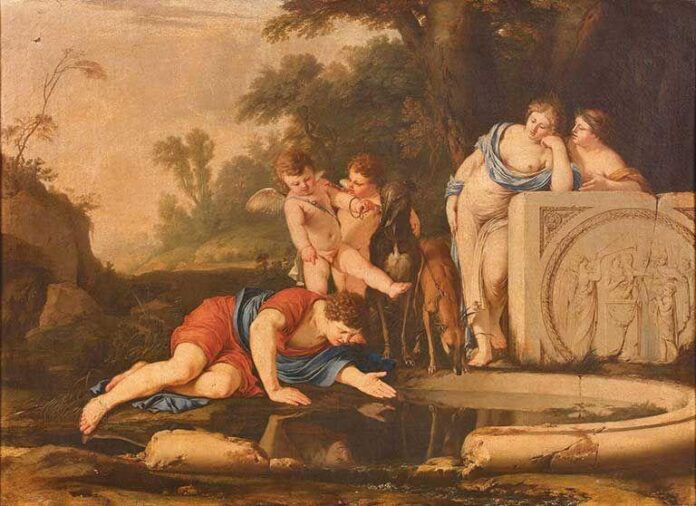A London dealer is at odds with Artcurial over a painting he purchased last year, for which he claims that the Paris auction house was unwilling to provide the requisite provenance information to comply with anti-money laundering (AML) rules. Artcurial insists that it adhered to all its obligations at all times, and cancelled the sale last month.
Patrick Matthiesen bought Narcissus (around 1640), a work recently reattributed to the French Baroque painter Laurent de la Hyre, for €918,400 (est €200,000-€300,000) on 9 November 2022. The large canvas had no provenance other than a 1929 “anonymous sale” at Christie’s in London. It had then disappeared but is mentioned by Pierre Rosenberg and Jacques Thuillier in their 1988 monograph on the artist. For a long time, the painting was mistakenly considered to be by the Neoclassical French painter Robert Lefèvre.
Specialists at Matthiesen’s gallery discovered that in 1929 the painting was sold as such by Lieutenant-Colonel Bernard Granville to a London family of dealers, the Vokins, for 49 guineas (around £4,300 today). “We also discovered that the painting was almost certainly part of the collection of Robert Walpole, the first Earl of Orford, at Strawberry Hill House [in London],” Matthiesen says.
One month after the Artcurial sale in November, the French state issued an export certificate. But Matthiesen says he could not transfer the painting to the UK as he had no information on its provenance after 1929. “Under AML procedures, we have to know who the seller is, and, if they are an agent, to find the ultimate beneficiary,” Matthiesen says. “Similar rules apply in America and there is no way we could sell the painting in the US with no information on its whereabouts for almost a century. Unfortunately, Artcurial was unable to provide any useful information.”
The dealer claims it took ten weeks to learn that the painting allegedly came “from a Belgian middle-class family”. When asked by Matthiesen for more information, Artcurial said it was “actually sold by a British company, which had purchased it last summer from the Belgian family for €30,000 as a work by Lefèvre”, he says, adding that he “could not access any information on any of these sources”.
Artcurial’s Old Master and 19th-century art specialist Matthieu Fournier says: “Artcurial is bound by French law to protect the anonymity of its clients. We do not have any historical record of the painting after 1929, but Patrick Matthiesen was aware of that when he bought the lot.” Fournier adds that the Belgian family has been informed of the change of attribution and value.
After formally requesting payment twice, the auction house cancelled the sale on 10 April “at the request of the seller”. Artcurial says it reserves the right to to seek compensation for its loss.
Meanwhile, Matthiesen has reported the case to several bodies, including the European Commission’s financial crime unit, which confirmed that “the AML directive requires auction houses to conduct effective customer due diligence and to file suspicious transaction reports” if there were any. The unit does not comment on specific cases, however.
Matthiesen was concerned by an inscription on the frame that reads “R. LeFevre, scuola francesa”, which suggests that the work was in Italy at some point. Furthermore, the dealer says Artcurial did not produce an export licence from Belgium. Artcurial’s response was that “an export licence was not needed to transfer the work from Belgium to France, but of course we have all the proper shipping documents”.
Matthiesen has also reported the case to the AML agencies in France and the UK, and has filed a claim to the magistrate tied to the French art market authority. The body declined to comment. But Artcurial says it has provided all the necessary documents and claims “many elements given to these institutions were erroneous, if not defamatory”.
“This is not the first time we’ve had this kind of problem in France,” Matthiesen says. “In other cases, too, we had to reconstitute the history of the lot by ourselves, with no help from the auctioneers. If some French auctioneers do not accept the need to be more transparent, British and American dealers will not continue buying from them.”

























